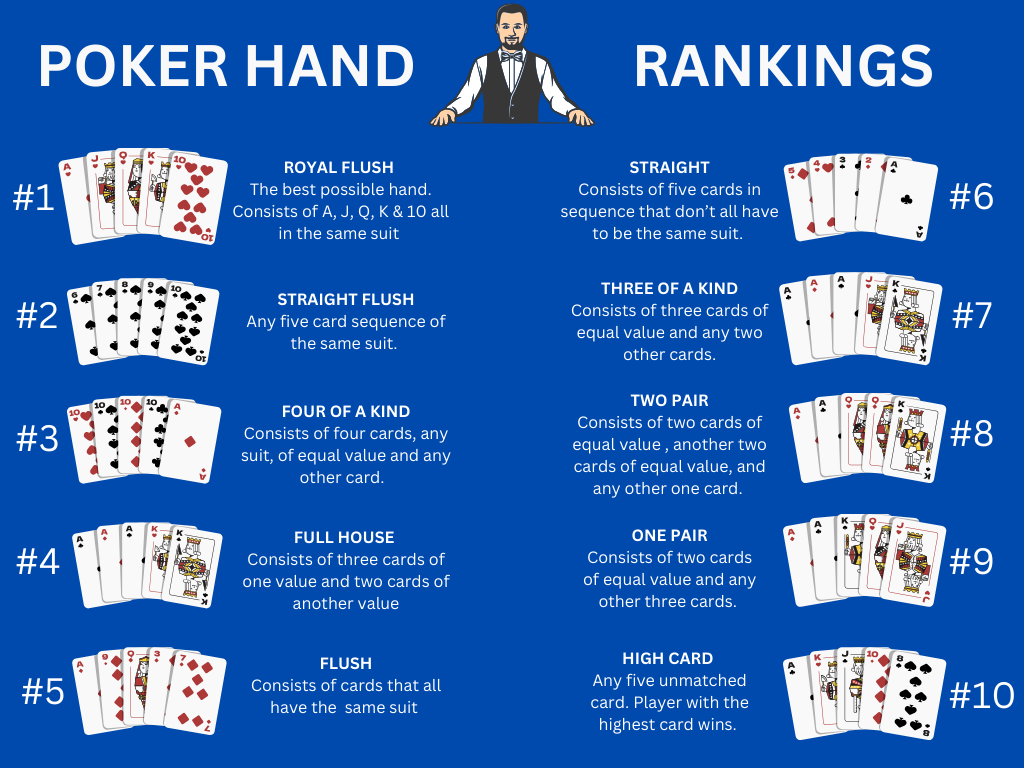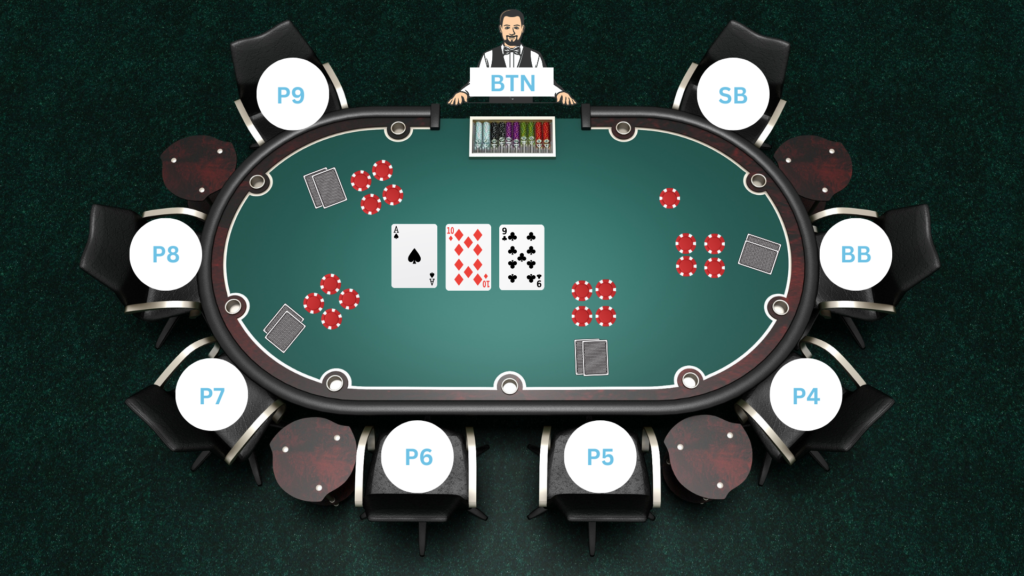Goal of the Game and Ranking System
The goal of poker is to create the best hand of five cards (or make it seem like you have the best hand). This is done by using the two cards dealt to you from the dealer and the five cards dealt to all players during the game. See below for that ranking system.

Positions of the Table
It’s important to know the positions of the table as that determines whose turn it is as the round progresses. Reference the chart below.

The acronyms are as follows:
BTN: Dealer Button: This player acts as the dealer of the cards for the round. For games where there isn’t an official dealer, like a poker game played with friends, the dealer is able to play as well. If they do play, they bet last in each betting round. For this tutorial, we’ll assume the game is at a casino and the dealer is NOT playing.
SB: Small Blind: The player immediately to the left of the dealer. Before cards are even dealt, this player posts a mandatory bet known as the small blind. This mandatory bet is determined by the table and is half of what the big blind has to bet.
BB: Big Blind: The player immediately to the left of the small blind. After the small blind posts their mandatory bet, the big blind also needs to post a mandatory bet. This amount is determined by the table.
P4 – P9: Players: These are the other players of the game. The different positions do have strategic advantages and disadvantages. However for simplicity, this tutorial will omit those since they aren’t fundamental to knowing the game.
Step 1: The Small and Big Blind Bet
The first step of poker, before cards are even dealt, is for the small and big blind to put down their mandatory bets. This bet is a minimum bet determined by the table. The small blind puts down half of what the big blind has to put down.

Step 2: Deal First Cards
After the small and big blinds have put down their bets, the dealer will deal two cards to each player in a clockwise order. Note to not show these cards to anyone. Once you receive the two cards, take a look at them and see if you want to put the additional bet that will be in step 3. Decide based on whether you think you can achieve a strong 5-card hand as the round progresses. If you don’t like your cards, you can choose to fold. Folding means that you quit the round.

Step 3: First Round of Betting and the Flop
Since the small and big blind have already placed their initial bet, the action starts with the player immediately to the left of the big blind. In this case, player 4. Player 4 has different decisions they can make based on the two cards they have been dealt. They can do one of three things:
Fold – To quit the round if they don’t believe they have any chance of winning.
Call – To stay in the game, match the bet of the player whose turn it was before. In this case, player 4 would look to match the big blind.
Raise – Set a new bet that is higher than the player before. The minimum raise is equal to the amount of the previous bet or raise. In this case, player 4’s minimum raise is two chips.
Let’s say player 4 raises. Next step is for the player to the left to make one of the same three decisions, fold, call or raise. This keeps on going all the way back to the big blind. If the big blind raises then another cycle of betting around the table occurs where every player gets the chance to match the raise, or can even raise it again themselves. If the big blind calls, the dealer introduces the flop, which is three community cards shown face up.

In this graphic, the bet was raised by 2 chips to a total of 4 chips. The BB, P5, P7 and P9 stayed in the game. One of those players raised while the rest called (matched the raise) to stay in the game. The other players showing no chips folded which means they’re done playing the round including the SB, who loses their one chip mandatory bet.
Step 4: Second Round of Betting and the Turn
Betting for each round in a game always starts with the first active player immediately to the left of the dealer, in this case the BB.
While the BB can’t technically call (no one raised before him yet), he can fold, raise or a third option now introduced which is checking.
Checking – staying in the hand without betting, but only if no one has bet before you. In this case, all players have 4 chips bet so until someone raises, all the players can check.
After the second round of betting, if at least two players are still in, an additional community card is dealt face-up. This is called the ‘turn.’

In this round, P5 folded. Since they already bet those 4 chips though, that goes into the pot. Players do not get the chips that they bet back after folding!
Step 5: Third Round of Betting and the River
Once the ‘turn’ is introduced, with the players left in the game, there is a third round of betting. This also starts with the first active player to the left of the dealer. It’s the same process as in step 3. Once the betting stops, the dealer gives the last community card, the ‘river.’

From the graphic you can see there was a raise and call by the players. No one folded and afterwards the ‘river’ was introduced, that last card which is an 8 of diamonds.
Step 6: Last Round of Betting
Once the river is introduced, there is one more final betting round starting with first active player to the left of the dealer. After the betting commences, the remaining players show their hand to determine who actually has the best hand, and gets the full money.

Step 7: Determine the Winner of the Round
Now that the remaining players have their cards flipped, determine the winner based on who has the highest card combination. Let’s take a look at each player’s card combination.

Player 9 has the best card combination with a flush. This means that player 9 gets all the money that was bet for that round.
Step 8: Starting Next Round
To start the next round, move the big blind, small blind and if not playing at a casino, the dealer one spot to the left and start the round with the same steps as shown in this tutorial.
Want more? Some Quik Tips
- If two players have the same hand, whoever has the highest valued cards win. For example, if Tim has a one pair of Kings, while Susan has a one pair of 10s, Tim wins the hand since Kings are higher than 10s.
- During the round, if all but one of players fold, then the player who didn’t fold keeps the money pot, and doesn’t even have to show their cards.



